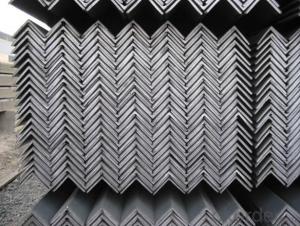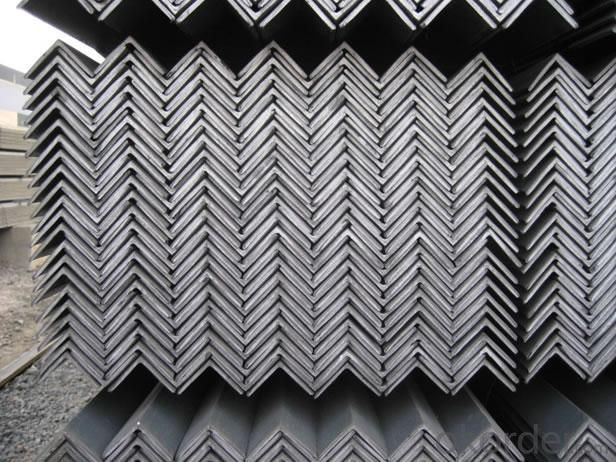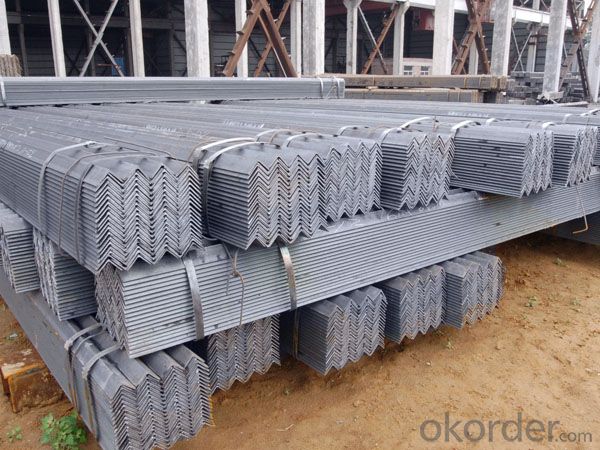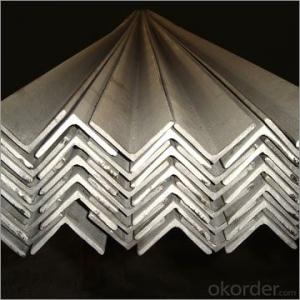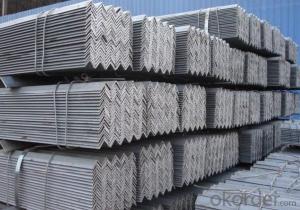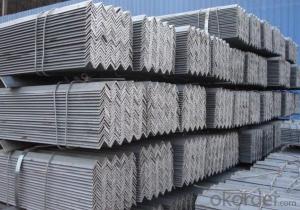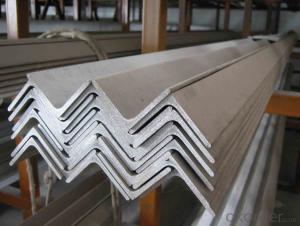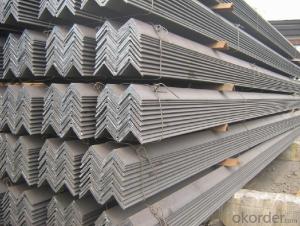Angle steel GB Q235B 20-250MM hot rolled
- Loading Port:
- Tianjin
- Payment Terms:
- TT OR LC
- Min Order Qty:
- 25 m.t.
- Supply Capability:
- 1000000 m.t./month
OKorder Service Pledge
OKorder Financial Service
You Might Also Like
Angle Steel Details:
| Minimum Order Quantity: | 25mtons | Unit: | m.t. | Loading Port: | China Main Port |
| Supply Ability: | 80000-100000MTS/YEAR | Payment Terms: | TT or LC |
Product Description:
Specifications of Angle Steel
1. Invoicing on theoretical weight or actual weight as customer request
2. Length: 6m, 9m, 12m as following table
3. Sizes
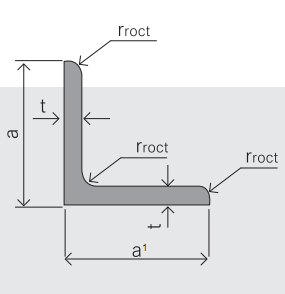
Sizes: 25mm-250mm | ||
a*t | ||
25*2.5-4.0 | 70*6.0-9.0 | 130*9.0-15 |
30*2.5-6.6 | 75*6.0-9.0 | 140*10-14 |
36*3.0-5.0 | 80*5.0-10 | 150*10-20 |
38*2.3-6.0 | 90*7.0-10 | 160*10-16 |
40*3.0-5.0 | 100*6.0-12 | 175*12-15 |
45*4.0-6.0 | 110*8.0-10 | 180*12-18 |
50*4.0-6.0 | 120*6.0-15 | 200*14-25 |
60*4.0-8.0 | 125*8.0-14 | 250*25 |
5. Payment terms:
1).100% irrevocable L/C at sight.
2).30% T/T prepaid and the balance against the copy of B/L.
3).30% T/T prepaid and the balance against L/C
6.Material details:
Alloy No | Grade | Element (%) | |||||
C | Mn | S | P | Si | |||
|
|
|
|
|
|
| |
Q235 | B | 0.12—0.20 | 0.3—0.7 | ≤0.045 | ≤0.045 | ≤0.3 | |
|
|
|
|
|
|
| |
Alloy No | Grade | Yielding strength point( Mpa) | |||||
Thickness (mm) | |||||||
≤16 | >16--40 | >40--60 | >60--100 | ||||
≥ | |||||||
|
|
|
|
|
| ||
Q235 | B | 235 | 225 | 215 | 205 | ||
Alloy No | Grade | Tensile strength (Mpa) | Elongation after fracture (%) | ||||
Thickness (mm) | |||||||
| ≤16 | >16--40 | >40--60 | >60--100 | |||
≥ | |||||||
|
|
|
|
|
|
| |
Q235 | B | 375--500 | 26 | 25 | 24 | 23 | |
Usage & Applications of Angle Steel
According to the needs of different structures, Angle can compose to different force support component, and also can be the connections between components. It is widely used in various building structures and engineering structures such as roof beams, bridges, transmission towers, hoisting machinery and transport machinery, ships, industrial furnaces, reaction tower, container frame and warehouse etc.
Packaging & Delivery of Angle Steel
1. Packing: it is nude packed in bundles by steel wire rod
2. Bundle weight: not more than 3.5MT for bulk vessel; less than 3 MT for container load
3. Marks:
Color marking: There will be color marking on both end of the bundle for the cargo delivered by bulk vessel. That makes it easily to distinguish at the destination port.
Tag mark: there will be tag mark tied up on the bundles. The information usually including supplier logo and name, product name, made in China, shipping marks and other information request by the customer.
If loading by container the marking is not needed, but we will prepare it as customer request.
Production flow of Angle Steel
Material prepare (billet) —heat up—rough rolling—precision rolling—cooling—packing—storage and transportation
- Q: Can steel angles be used for manufacturing support brackets?
- Yes, steel angles can be used for manufacturing support brackets. Steel angles are commonly used in construction and manufacturing industries due to their strength, durability, and versatility. They provide excellent support and stability, making them ideal for creating brackets that can withstand heavy loads and provide structural support.
- Q: How do steel angles perform under seismic loads?
- Steel angles are commonly used in construction to provide structural support and reinforcement. When subjected to seismic loads, steel angles have been found to perform exceptionally well due to their inherent properties and design flexibility. One key advantage of steel angles is their high strength-to-weight ratio. This allows them to withstand the intense forces and movements generated during an earthquake without significant deformation or failure. The compact shape of the angle also helps distribute the load more efficiently, minimizing stress concentrations and potential weak points. Moreover, steel angles can be easily connected to other structural elements, providing a robust and reliable connection system. This is particularly important in seismic design, where the ability to transfer forces and accommodate movements is essential. To further enhance their performance under seismic loads, steel angles can be designed with specific features. For instance, the addition of stiffeners or bracing elements can increase their resistance to lateral forces, reducing the risk of buckling or collapse. Additionally, the use of thicker and stronger steel grades can improve their overall capacity to absorb and dissipate seismic energy. Various seismic design codes and standards provide guidelines and requirements for the use of steel angles in seismic-resistant structures. These codes consider factors such as the maximum allowable stress levels, detailing requirements for connections, and the overall structural behavior under seismic actions. In conclusion, steel angles perform admirably under seismic loads due to their high strength-to-weight ratio, efficient load distribution, and flexibility in design. When properly designed and implemented, steel angles can effectively resist the forces and movements generated during an earthquake, ensuring the structural integrity and safety of the building.
- Q: How do you determine the torsional stiffness of a steel angle?
- The torsional stiffness of a steel angle can be determined by calculating the polar moment of inertia of the cross-sectional area of the angle. This can be done by considering the geometry and dimensions of the angle and using the appropriate formulas. Once the polar moment of inertia is determined, it can be used to calculate the torsional stiffness of the steel angle.
- Q: Are steel angles suitable for earthquake-resistant construction?
- Steel angles can indeed be suitable for earthquake-resistant construction. Steel is a material known for its high strength and ductility, making it ideal for withstanding seismic forces. Steel angles, in particular, are commonly used in seismic design and construction due to their ability to provide structural stability. Steel angles are often used as bracing elements in buildings to resist lateral forces caused by earthquakes. They can be installed diagonally between structural members to create a rigid frame that can effectively absorb and dissipate seismic energy. These angles help distribute the forces generated during an earthquake and prevent the collapse of the structure. Furthermore, steel angles can be designed and fabricated to meet specific seismic design criteria. The design can take into account factors such as the building's location, expected seismic activity, and the desired level of earthquake resistance. By using advanced computer-aided design and analysis tools, engineers can optimize the placement and size of steel angles to enhance the overall seismic performance of the structure. In addition to their strength and ductility, steel angles offer other advantages for earthquake-resistant construction. They are lightweight, which reduces the overall weight of the structure and allows for more efficient seismic design. Steel is also a recyclable material, making it a sustainable choice for construction projects. However, it is important to note that the suitability of steel angles for earthquake-resistant construction depends on several factors, including the specific design, construction techniques, and adherence to building codes and regulations. Professional engineering expertise and thorough analysis are necessary to ensure the appropriate use of steel angles in seismic design. In summary, steel angles are suitable for earthquake-resistant construction due to their strength, ductility, and ability to provide structural stability. When properly designed and installed, they can effectively resist seismic forces and contribute to the overall safety and resilience of the structure.
- Q: What's the size of the 50 angle iron?
- Specification for 50 equal anglesTwo sides at right angles, 90 degrees. The length of the side is 50mm, and the thickness of the edge is 3mm, 4mm, 5mm and 6mm. The corresponding weight of each meter is 2.332 kg, 3.059 kg, 3.770 kg, 4.465 kg, respectively, four kg.
- Q: What are the different design considerations for steel angles in architectural applications?
- Some of the different design considerations for steel angles in architectural applications include the load-bearing capacity, structural stability, aesthetic appeal, corrosion resistance, and ease of installation. Additionally, factors like the size and shape of the angles, the type of steel used, and the specific architectural requirements also play a role in the design process.
- Q: Are there any specific design considerations when using steel angles?
- Yes, there are several specific design considerations when using steel angles. Firstly, it is important to consider the load-bearing capacity of the steel angles. Steel angles are commonly used in structural applications where they need to carry significant loads. Therefore, it is crucial to determine the required strength and stiffness of the angles based on the anticipated loads and design requirements. Secondly, the connection details of the steel angles should be carefully designed. The connection between steel angles and other structural members or components needs to be strong and secure. Various methods such as bolting, welding, or using additional plates or brackets may be employed to ensure the stability and integrity of the connections. Additionally, the stability of the steel angles themselves must be considered. Lateral-torsional buckling is a potential failure mode for long and slender steel angles subjected to bending loads. Therefore, appropriate measures, such as bracing or increasing the section modulus, should be taken to enhance the stability of the angles. Furthermore, steel angles may be vulnerable to corrosion, especially in outdoor or corrosive environments. Adequate protective coatings or treatments should be applied to prevent or minimize corrosion, ensuring the long-term durability and performance of the angles. Lastly, aesthetic considerations may also come into play when using steel angles in architectural or design applications. The appearance of the steel angles, such as the surface finish or color, should be taken into account to achieve the desired visual effect. In summary, the load-bearing capacity, connection details, stability, corrosion protection, and aesthetic aspects are some of the specific design considerations that should be taken into account when using steel angles. These considerations are essential to ensure the structural integrity, durability, and overall performance of the steel angle applications.
- Q: Can steel angles be used as bracing elements?
- Indeed, steel angles have the capability to serve as bracing elements. Construction and engineering projects frequently employ steel angles due to their robustness and longevity. These angles are commonly utilized to furnish structural support and stability, including as bracing elements. A rigid and secure bracing system can be established by either bolting or welding steel angles to other structural components. The design of these angles, with their L-shape, facilitates easy attachment to other members, thus imparting additional strength and resilience against lateral forces like wind or seismic loads. In summary, steel angles are a dependable choice for bracing elements across a wide range of applications, encompassing buildings, bridges, and industrial structures.
- Q: Can steel angles be used in temporary or modular structures?
- Yes, steel angles can be used in temporary or modular structures. Steel angles are commonly used in construction due to their strength, versatility, and cost-effectiveness. They are often used to provide structural support and stability in various applications, including temporary or modular structures. Steel angles can be easily cut, welded, and bolted, making them suitable for assembling and disassembling temporary or modular structures. Additionally, steel angles can withstand heavy loads and provide excellent resistance against bending and twisting forces, ensuring the stability and safety of the structure.
- Q: Can steel angles be used as supports for mechanical or electrical equipment?
- Yes, steel angles can be used as supports for mechanical or electrical equipment. Steel angles are versatile and strong, making them suitable for a wide range of applications. They can provide stability, rigidity, and support to hold mechanical or electrical equipment in place. The L-shaped design of steel angles allows for easy attachment and installation, making them convenient for various mounting needs. Additionally, steel angles can be easily customized and fabricated to meet specific requirements, ensuring a secure and reliable support system for the equipment.
Send your message to us
Angle steel GB Q235B 20-250MM hot rolled
- Loading Port:
- Tianjin
- Payment Terms:
- TT OR LC
- Min Order Qty:
- 25 m.t.
- Supply Capability:
- 1000000 m.t./month
OKorder Service Pledge
OKorder Financial Service
Similar products
Hot products
Hot Searches
Related keywords
